Leadership Journey: Reflecting on Learning Organizations and Theories
VerifiedAdded on 2021/05/30
|8
|2264
|70
Essay
AI Summary
This essay delves into the multifaceted realm of leadership by examining it through the lens of organizational learning. It explores the core concepts of leadership, emphasizing the leader's role in guiding organizations toward sustained success and business sustainability. The essay begins by defining leadership and its significance in both organizational and personal contexts, drawing upon John Maxwell's definition of a leader as one who knows, goes, and shows the way. The essay then explores two primary schools of thought on organizational learning: the cognitive school, which focuses on the 'thinking' aspect, and the behavioral school, emphasizing the 'doing' aspect. It then discusses three key organizational learning theories: experiential learning, adaptive and generative learning, and assimilation theory, illustrating how these theories inform the art of knowing, going, and showing in leadership. The essay uses these theories to reflect on the author's personal leadership journey, providing examples and insights from their experience at Amazon, highlighting the application of adaptive and generative learning in their professional conduct. Ultimately, the essay underscores the importance of adapting leadership styles based on organizational learning theories and the leader's ability to respond effectively to different situations. The essay concludes by reiterating the crucial role of a leader in knowing the way, going the way, and showing the way to achieve organizational success.
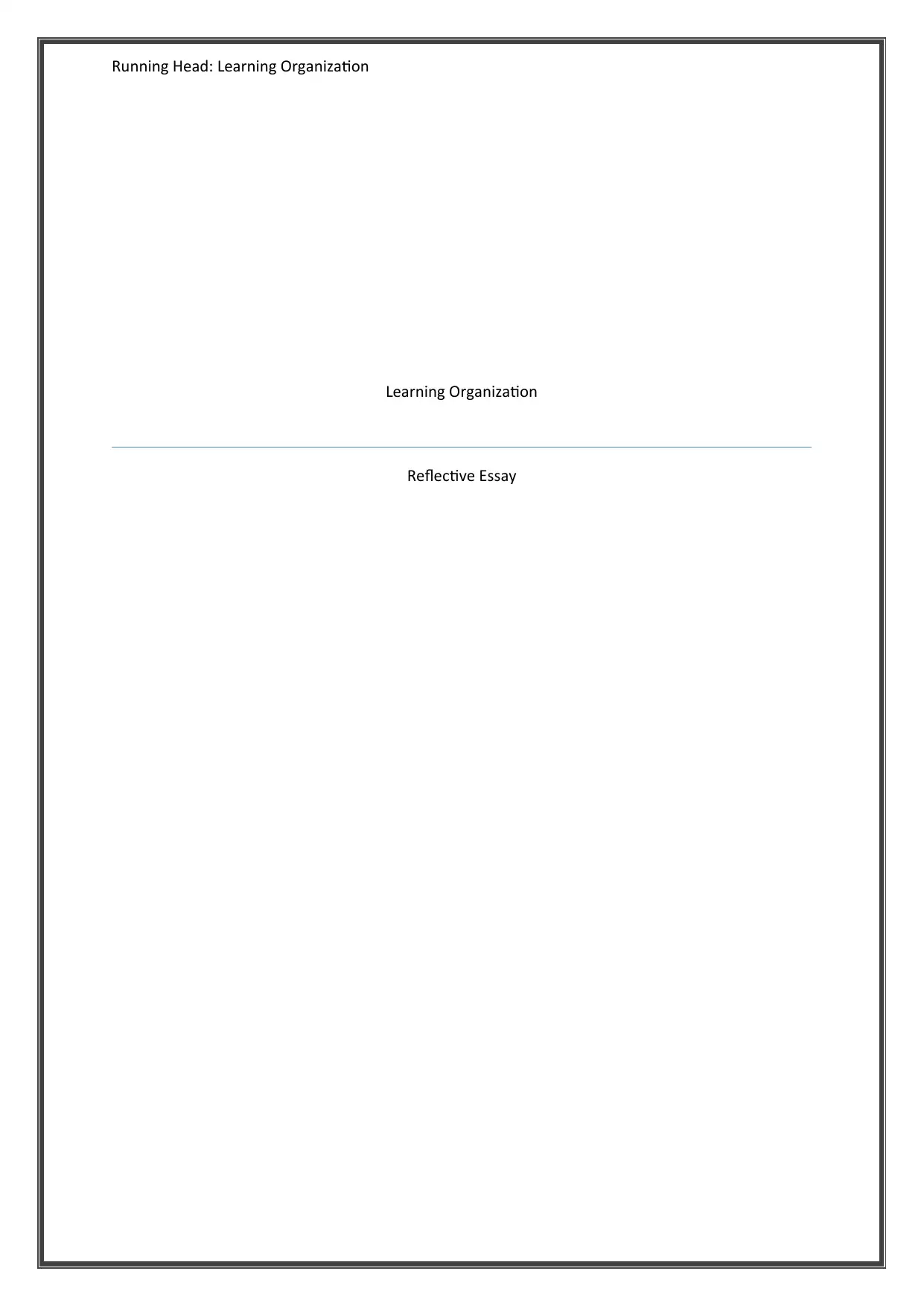
Running Head: Learning Organization
Learning Organization
Reflective Essay
Learning Organization
Reflective Essay
Paraphrase This Document
Need a fresh take? Get an instant paraphrase of this document with our AI Paraphraser
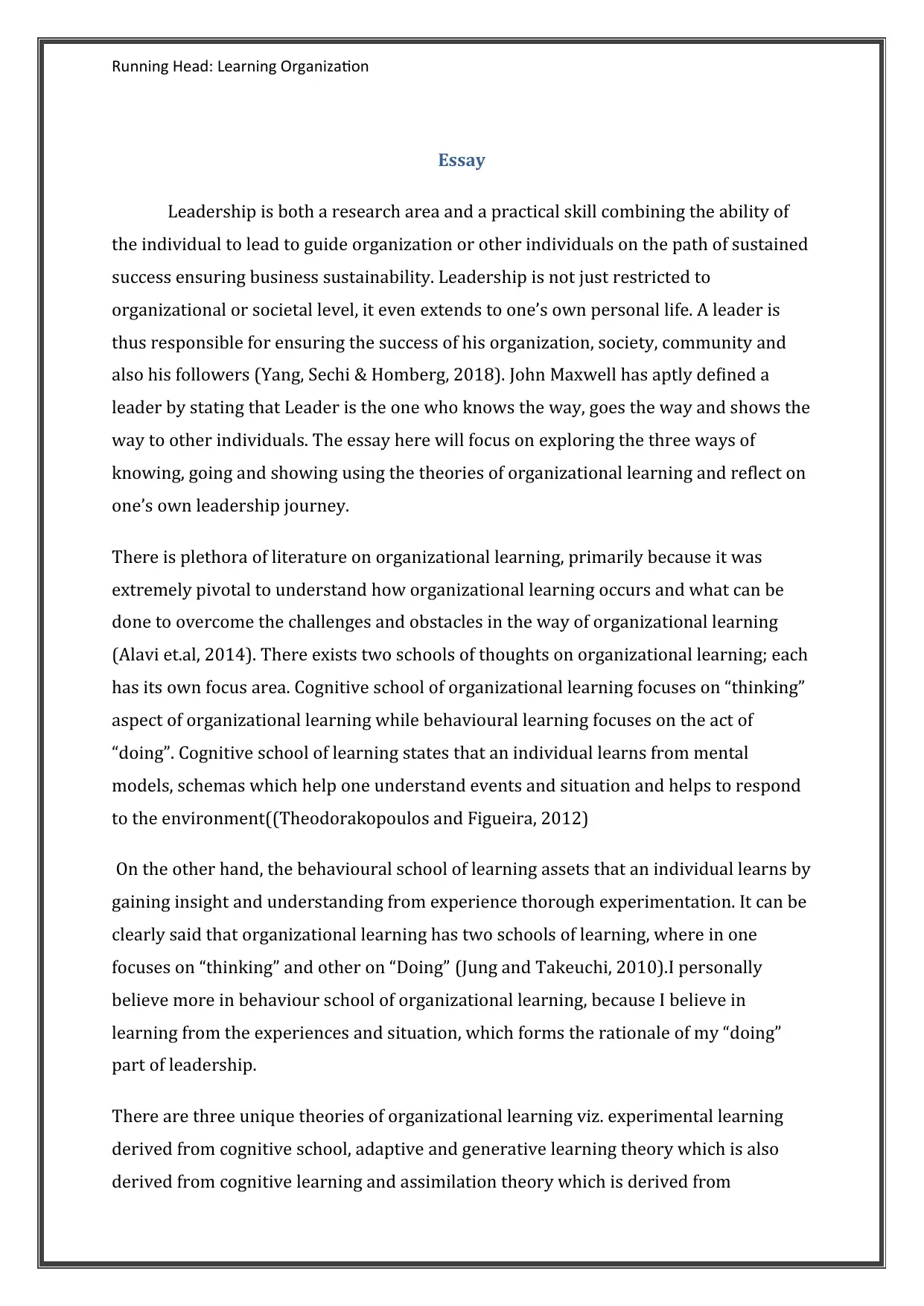
Running Head: Learning Organization
Essay
Leadership is both a research area and a practical skill combining the ability of
the individual to lead to guide organization or other individuals on the path of sustained
success ensuring business sustainability. Leadership is not just restricted to
organizational or societal level, it even extends to one’s own personal life. A leader is
thus responsible for ensuring the success of his organization, society, community and
also his followers (Yang, Sechi & Homberg, 2018). John Maxwell has aptly defined a
leader by stating that Leader is the one who knows the way, goes the way and shows the
way to other individuals. The essay here will focus on exploring the three ways of
knowing, going and showing using the theories of organizational learning and reflect on
one’s own leadership journey.
There is plethora of literature on organizational learning, primarily because it was
extremely pivotal to understand how organizational learning occurs and what can be
done to overcome the challenges and obstacles in the way of organizational learning
(Alavi et.al, 2014). There exists two schools of thoughts on organizational learning; each
has its own focus area. Cognitive school of organizational learning focuses on “thinking”
aspect of organizational learning while behavioural learning focuses on the act of
“doing”. Cognitive school of learning states that an individual learns from mental
models, schemas which help one understand events and situation and helps to respond
to the environment((Theodorakopoulos and Figueira, 2012)
On the other hand, the behavioural school of learning assets that an individual learns by
gaining insight and understanding from experience thorough experimentation. It can be
clearly said that organizational learning has two schools of learning, where in one
focuses on “thinking” and other on “Doing” (Jung and Takeuchi, 2010).I personally
believe more in behaviour school of organizational learning, because I believe in
learning from the experiences and situation, which forms the rationale of my “doing”
part of leadership.
There are three unique theories of organizational learning viz. experimental learning
derived from cognitive school, adaptive and generative learning theory which is also
derived from cognitive learning and assimilation theory which is derived from
Essay
Leadership is both a research area and a practical skill combining the ability of
the individual to lead to guide organization or other individuals on the path of sustained
success ensuring business sustainability. Leadership is not just restricted to
organizational or societal level, it even extends to one’s own personal life. A leader is
thus responsible for ensuring the success of his organization, society, community and
also his followers (Yang, Sechi & Homberg, 2018). John Maxwell has aptly defined a
leader by stating that Leader is the one who knows the way, goes the way and shows the
way to other individuals. The essay here will focus on exploring the three ways of
knowing, going and showing using the theories of organizational learning and reflect on
one’s own leadership journey.
There is plethora of literature on organizational learning, primarily because it was
extremely pivotal to understand how organizational learning occurs and what can be
done to overcome the challenges and obstacles in the way of organizational learning
(Alavi et.al, 2014). There exists two schools of thoughts on organizational learning; each
has its own focus area. Cognitive school of organizational learning focuses on “thinking”
aspect of organizational learning while behavioural learning focuses on the act of
“doing”. Cognitive school of learning states that an individual learns from mental
models, schemas which help one understand events and situation and helps to respond
to the environment((Theodorakopoulos and Figueira, 2012)
On the other hand, the behavioural school of learning assets that an individual learns by
gaining insight and understanding from experience thorough experimentation. It can be
clearly said that organizational learning has two schools of learning, where in one
focuses on “thinking” and other on “Doing” (Jung and Takeuchi, 2010).I personally
believe more in behaviour school of organizational learning, because I believe in
learning from the experiences and situation, which forms the rationale of my “doing”
part of leadership.
There are three unique theories of organizational learning viz. experimental learning
derived from cognitive school, adaptive and generative learning theory which is also
derived from cognitive learning and assimilation theory which is derived from
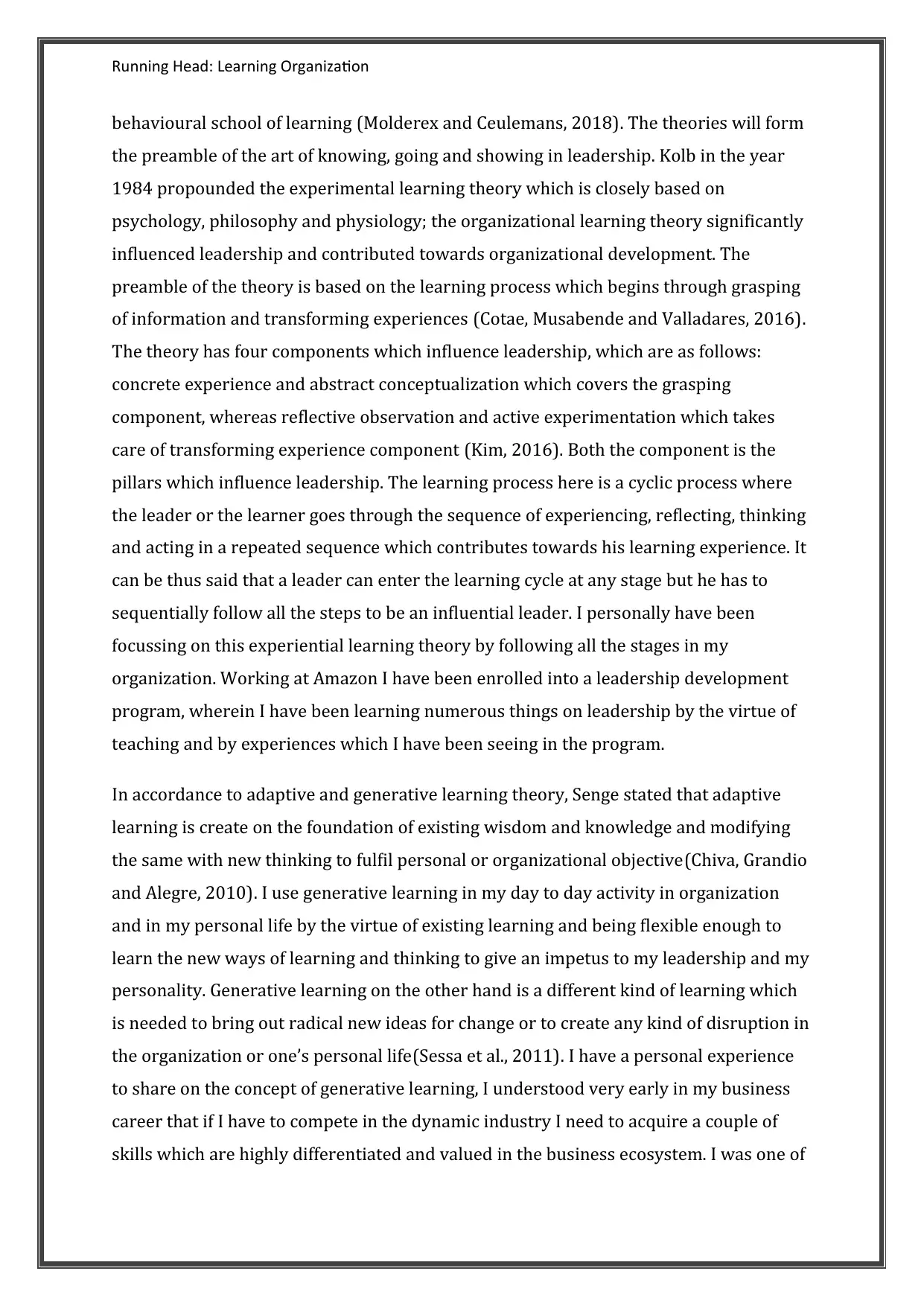
Running Head: Learning Organization
behavioural school of learning (Molderex and Ceulemans, 2018). The theories will form
the preamble of the art of knowing, going and showing in leadership. Kolb in the year
1984 propounded the experimental learning theory which is closely based on
psychology, philosophy and physiology; the organizational learning theory significantly
influenced leadership and contributed towards organizational development. The
preamble of the theory is based on the learning process which begins through grasping
of information and transforming experiences (Cotae, Musabende and Valladares, 2016).
The theory has four components which influence leadership, which are as follows:
concrete experience and abstract conceptualization which covers the grasping
component, whereas reflective observation and active experimentation which takes
care of transforming experience component (Kim, 2016). Both the component is the
pillars which influence leadership. The learning process here is a cyclic process where
the leader or the learner goes through the sequence of experiencing, reflecting, thinking
and acting in a repeated sequence which contributes towards his learning experience. It
can be thus said that a leader can enter the learning cycle at any stage but he has to
sequentially follow all the steps to be an influential leader. I personally have been
focussing on this experiential learning theory by following all the stages in my
organization. Working at Amazon I have been enrolled into a leadership development
program, wherein I have been learning numerous things on leadership by the virtue of
teaching and by experiences which I have been seeing in the program.
In accordance to adaptive and generative learning theory, Senge stated that adaptive
learning is create on the foundation of existing wisdom and knowledge and modifying
the same with new thinking to fulfil personal or organizational objective(Chiva, Grandio
and Alegre, 2010). I use generative learning in my day to day activity in organization
and in my personal life by the virtue of existing learning and being flexible enough to
learn the new ways of learning and thinking to give an impetus to my leadership and my
personality. Generative learning on the other hand is a different kind of learning which
is needed to bring out radical new ideas for change or to create any kind of disruption in
the organization or one’s personal life(Sessa et al., 2011). I have a personal experience
to share on the concept of generative learning, I understood very early in my business
career that if I have to compete in the dynamic industry I need to acquire a couple of
skills which are highly differentiated and valued in the business ecosystem. I was one of
behavioural school of learning (Molderex and Ceulemans, 2018). The theories will form
the preamble of the art of knowing, going and showing in leadership. Kolb in the year
1984 propounded the experimental learning theory which is closely based on
psychology, philosophy and physiology; the organizational learning theory significantly
influenced leadership and contributed towards organizational development. The
preamble of the theory is based on the learning process which begins through grasping
of information and transforming experiences (Cotae, Musabende and Valladares, 2016).
The theory has four components which influence leadership, which are as follows:
concrete experience and abstract conceptualization which covers the grasping
component, whereas reflective observation and active experimentation which takes
care of transforming experience component (Kim, 2016). Both the component is the
pillars which influence leadership. The learning process here is a cyclic process where
the leader or the learner goes through the sequence of experiencing, reflecting, thinking
and acting in a repeated sequence which contributes towards his learning experience. It
can be thus said that a leader can enter the learning cycle at any stage but he has to
sequentially follow all the steps to be an influential leader. I personally have been
focussing on this experiential learning theory by following all the stages in my
organization. Working at Amazon I have been enrolled into a leadership development
program, wherein I have been learning numerous things on leadership by the virtue of
teaching and by experiences which I have been seeing in the program.
In accordance to adaptive and generative learning theory, Senge stated that adaptive
learning is create on the foundation of existing wisdom and knowledge and modifying
the same with new thinking to fulfil personal or organizational objective(Chiva, Grandio
and Alegre, 2010). I use generative learning in my day to day activity in organization
and in my personal life by the virtue of existing learning and being flexible enough to
learn the new ways of learning and thinking to give an impetus to my leadership and my
personality. Generative learning on the other hand is a different kind of learning which
is needed to bring out radical new ideas for change or to create any kind of disruption in
the organization or one’s personal life(Sessa et al., 2011). I have a personal experience
to share on the concept of generative learning, I understood very early in my business
career that if I have to compete in the dynamic industry I need to acquire a couple of
skills which are highly differentiated and valued in the business ecosystem. I was one of
⊘ This is a preview!⊘
Do you want full access?
Subscribe today to unlock all pages.

Trusted by 1+ million students worldwide
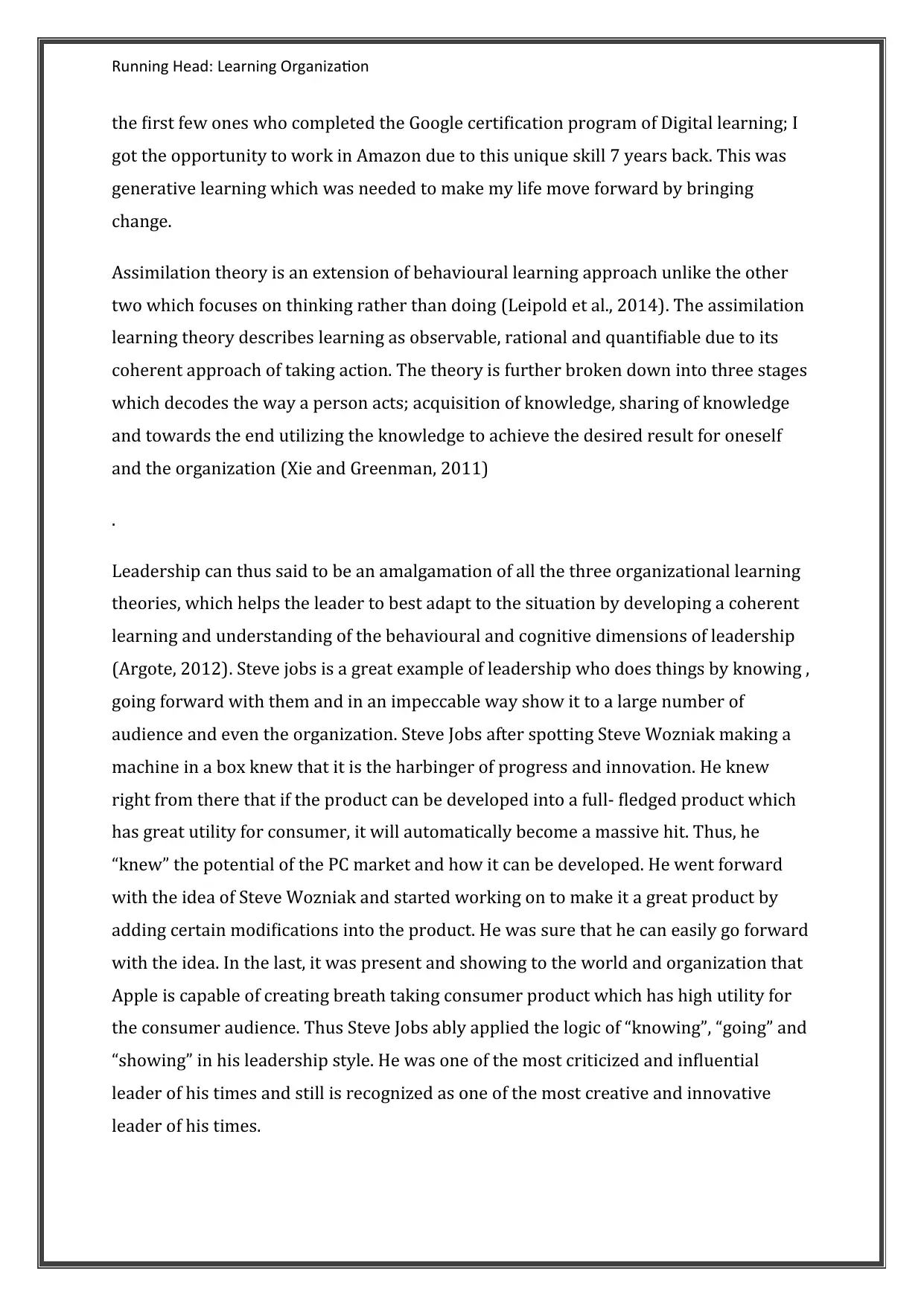
Running Head: Learning Organization
the first few ones who completed the Google certification program of Digital learning; I
got the opportunity to work in Amazon due to this unique skill 7 years back. This was
generative learning which was needed to make my life move forward by bringing
change.
Assimilation theory is an extension of behavioural learning approach unlike the other
two which focuses on thinking rather than doing (Leipold et al., 2014). The assimilation
learning theory describes learning as observable, rational and quantifiable due to its
coherent approach of taking action. The theory is further broken down into three stages
which decodes the way a person acts; acquisition of knowledge, sharing of knowledge
and towards the end utilizing the knowledge to achieve the desired result for oneself
and the organization (Xie and Greenman, 2011)
.
Leadership can thus said to be an amalgamation of all the three organizational learning
theories, which helps the leader to best adapt to the situation by developing a coherent
learning and understanding of the behavioural and cognitive dimensions of leadership
(Argote, 2012). Steve jobs is a great example of leadership who does things by knowing ,
going forward with them and in an impeccable way show it to a large number of
audience and even the organization. Steve Jobs after spotting Steve Wozniak making a
machine in a box knew that it is the harbinger of progress and innovation. He knew
right from there that if the product can be developed into a full- fledged product which
has great utility for consumer, it will automatically become a massive hit. Thus, he
“knew” the potential of the PC market and how it can be developed. He went forward
with the idea of Steve Wozniak and started working on to make it a great product by
adding certain modifications into the product. He was sure that he can easily go forward
with the idea. In the last, it was present and showing to the world and organization that
Apple is capable of creating breath taking consumer product which has high utility for
the consumer audience. Thus Steve Jobs ably applied the logic of “knowing”, “going” and
“showing” in his leadership style. He was one of the most criticized and influential
leader of his times and still is recognized as one of the most creative and innovative
leader of his times.
the first few ones who completed the Google certification program of Digital learning; I
got the opportunity to work in Amazon due to this unique skill 7 years back. This was
generative learning which was needed to make my life move forward by bringing
change.
Assimilation theory is an extension of behavioural learning approach unlike the other
two which focuses on thinking rather than doing (Leipold et al., 2014). The assimilation
learning theory describes learning as observable, rational and quantifiable due to its
coherent approach of taking action. The theory is further broken down into three stages
which decodes the way a person acts; acquisition of knowledge, sharing of knowledge
and towards the end utilizing the knowledge to achieve the desired result for oneself
and the organization (Xie and Greenman, 2011)
.
Leadership can thus said to be an amalgamation of all the three organizational learning
theories, which helps the leader to best adapt to the situation by developing a coherent
learning and understanding of the behavioural and cognitive dimensions of leadership
(Argote, 2012). Steve jobs is a great example of leadership who does things by knowing ,
going forward with them and in an impeccable way show it to a large number of
audience and even the organization. Steve Jobs after spotting Steve Wozniak making a
machine in a box knew that it is the harbinger of progress and innovation. He knew
right from there that if the product can be developed into a full- fledged product which
has great utility for consumer, it will automatically become a massive hit. Thus, he
“knew” the potential of the PC market and how it can be developed. He went forward
with the idea of Steve Wozniak and started working on to make it a great product by
adding certain modifications into the product. He was sure that he can easily go forward
with the idea. In the last, it was present and showing to the world and organization that
Apple is capable of creating breath taking consumer product which has high utility for
the consumer audience. Thus Steve Jobs ably applied the logic of “knowing”, “going” and
“showing” in his leadership style. He was one of the most criticized and influential
leader of his times and still is recognized as one of the most creative and innovative
leader of his times.
Paraphrase This Document
Need a fresh take? Get an instant paraphrase of this document with our AI Paraphraser
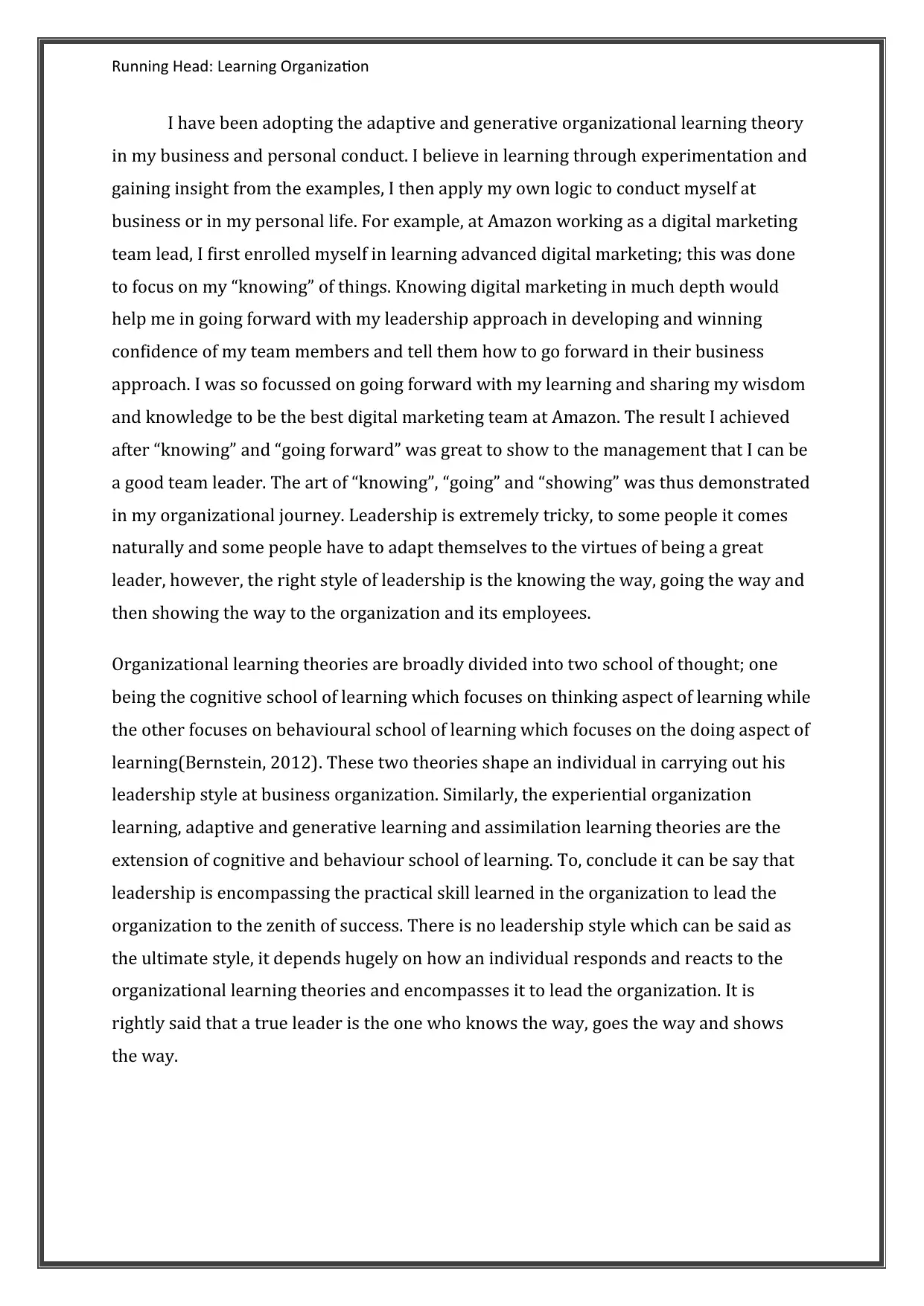
Running Head: Learning Organization
I have been adopting the adaptive and generative organizational learning theory
in my business and personal conduct. I believe in learning through experimentation and
gaining insight from the examples, I then apply my own logic to conduct myself at
business or in my personal life. For example, at Amazon working as a digital marketing
team lead, I first enrolled myself in learning advanced digital marketing; this was done
to focus on my “knowing” of things. Knowing digital marketing in much depth would
help me in going forward with my leadership approach in developing and winning
confidence of my team members and tell them how to go forward in their business
approach. I was so focussed on going forward with my learning and sharing my wisdom
and knowledge to be the best digital marketing team at Amazon. The result I achieved
after “knowing” and “going forward” was great to show to the management that I can be
a good team leader. The art of “knowing”, “going” and “showing” was thus demonstrated
in my organizational journey. Leadership is extremely tricky, to some people it comes
naturally and some people have to adapt themselves to the virtues of being a great
leader, however, the right style of leadership is the knowing the way, going the way and
then showing the way to the organization and its employees.
Organizational learning theories are broadly divided into two school of thought; one
being the cognitive school of learning which focuses on thinking aspect of learning while
the other focuses on behavioural school of learning which focuses on the doing aspect of
learning(Bernstein, 2012). These two theories shape an individual in carrying out his
leadership style at business organization. Similarly, the experiential organization
learning, adaptive and generative learning and assimilation learning theories are the
extension of cognitive and behaviour school of learning. To, conclude it can be say that
leadership is encompassing the practical skill learned in the organization to lead the
organization to the zenith of success. There is no leadership style which can be said as
the ultimate style, it depends hugely on how an individual responds and reacts to the
organizational learning theories and encompasses it to lead the organization. It is
rightly said that a true leader is the one who knows the way, goes the way and shows
the way.
I have been adopting the adaptive and generative organizational learning theory
in my business and personal conduct. I believe in learning through experimentation and
gaining insight from the examples, I then apply my own logic to conduct myself at
business or in my personal life. For example, at Amazon working as a digital marketing
team lead, I first enrolled myself in learning advanced digital marketing; this was done
to focus on my “knowing” of things. Knowing digital marketing in much depth would
help me in going forward with my leadership approach in developing and winning
confidence of my team members and tell them how to go forward in their business
approach. I was so focussed on going forward with my learning and sharing my wisdom
and knowledge to be the best digital marketing team at Amazon. The result I achieved
after “knowing” and “going forward” was great to show to the management that I can be
a good team leader. The art of “knowing”, “going” and “showing” was thus demonstrated
in my organizational journey. Leadership is extremely tricky, to some people it comes
naturally and some people have to adapt themselves to the virtues of being a great
leader, however, the right style of leadership is the knowing the way, going the way and
then showing the way to the organization and its employees.
Organizational learning theories are broadly divided into two school of thought; one
being the cognitive school of learning which focuses on thinking aspect of learning while
the other focuses on behavioural school of learning which focuses on the doing aspect of
learning(Bernstein, 2012). These two theories shape an individual in carrying out his
leadership style at business organization. Similarly, the experiential organization
learning, adaptive and generative learning and assimilation learning theories are the
extension of cognitive and behaviour school of learning. To, conclude it can be say that
leadership is encompassing the practical skill learned in the organization to lead the
organization to the zenith of success. There is no leadership style which can be said as
the ultimate style, it depends hugely on how an individual responds and reacts to the
organizational learning theories and encompasses it to lead the organization. It is
rightly said that a true leader is the one who knows the way, goes the way and shows
the way.
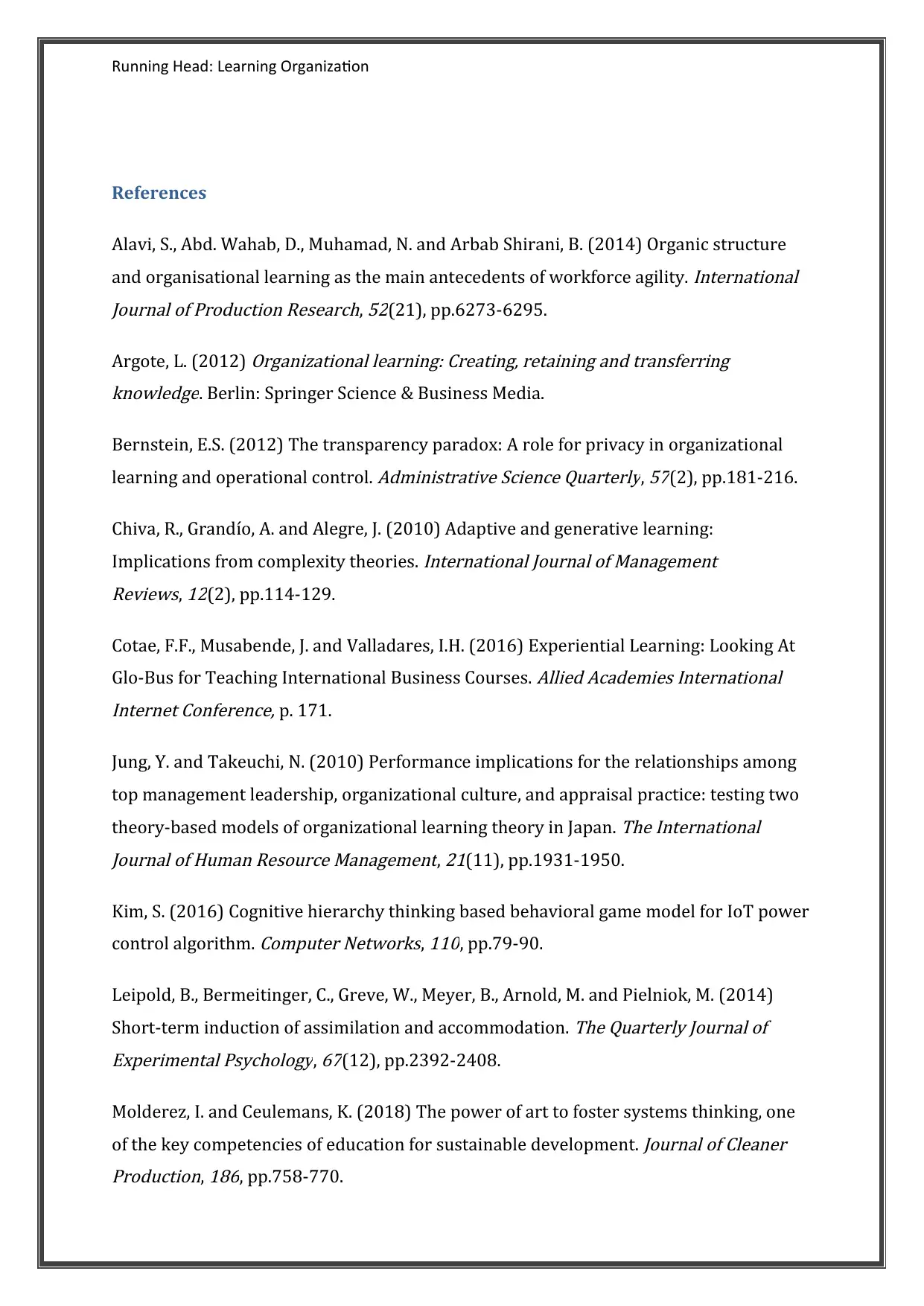
Running Head: Learning Organization
References
Alavi, S., Abd. Wahab, D., Muhamad, N. and Arbab Shirani, B. (2014) Organic structure
and organisational learning as the main antecedents of workforce agility.
International
Journal of Production Research,
52(21), pp.6273-6295.
Argote, L. (2012)
Organizational learning: Creating, retaining and transferring
knowledge. Berlin: Springer Science & Business Media.
Bernstein, E.S. (2012) The transparency paradox: A role for privacy in organizational
learning and operational control.
Administrative Science Quarterly,
57(2), pp.181-216.
Chiva, R., GrandíKo, A. and Alegre, J. (2010) Adaptive and generative learning:
Implications from complexity theories.
International Journal of Management
Reviews,
12(2), pp.114-129.
Cotae, F.F., Musabende, J. and Valladares, I.H. (2016) Experiential Learning: Looking At
Glo-Bus for Teaching International Business Courses.
Allied Academies International
Internet Conference, p. 171.
Jung, Y. and Takeuchi, N. (2010) Performance implications for the relationships among
top management leadership, organizational culture, and appraisal practice: testing two
theory-based models of organizational learning theory in Japan.
The International
Journal of Human Resource Management,
21(11), pp.1931-1950.
Kim, S. (2016) Cognitive hierarchy thinking based behavioral game model for IoT power
control algorithm.
Computer Networks,
110, pp.79-90.
Leipold, B., Bermeitinger, C., Greve, W., Meyer, B., Arnold, M. and Pielniok, M. (2014)
Short-term induction of assimilation and accommodation.
The Quarterly Journal of
Experimental Psychology,
67(12), pp.2392-2408.
Molderez, I. and Ceulemans, K. (2018) The power of art to foster systems thinking, one
of the key competencies of education for sustainable development.
Journal of Cleaner
Production,
186, pp.758-770.
References
Alavi, S., Abd. Wahab, D., Muhamad, N. and Arbab Shirani, B. (2014) Organic structure
and organisational learning as the main antecedents of workforce agility.
International
Journal of Production Research,
52(21), pp.6273-6295.
Argote, L. (2012)
Organizational learning: Creating, retaining and transferring
knowledge. Berlin: Springer Science & Business Media.
Bernstein, E.S. (2012) The transparency paradox: A role for privacy in organizational
learning and operational control.
Administrative Science Quarterly,
57(2), pp.181-216.
Chiva, R., GrandíKo, A. and Alegre, J. (2010) Adaptive and generative learning:
Implications from complexity theories.
International Journal of Management
Reviews,
12(2), pp.114-129.
Cotae, F.F., Musabende, J. and Valladares, I.H. (2016) Experiential Learning: Looking At
Glo-Bus for Teaching International Business Courses.
Allied Academies International
Internet Conference, p. 171.
Jung, Y. and Takeuchi, N. (2010) Performance implications for the relationships among
top management leadership, organizational culture, and appraisal practice: testing two
theory-based models of organizational learning theory in Japan.
The International
Journal of Human Resource Management,
21(11), pp.1931-1950.
Kim, S. (2016) Cognitive hierarchy thinking based behavioral game model for IoT power
control algorithm.
Computer Networks,
110, pp.79-90.
Leipold, B., Bermeitinger, C., Greve, W., Meyer, B., Arnold, M. and Pielniok, M. (2014)
Short-term induction of assimilation and accommodation.
The Quarterly Journal of
Experimental Psychology,
67(12), pp.2392-2408.
Molderez, I. and Ceulemans, K. (2018) The power of art to foster systems thinking, one
of the key competencies of education for sustainable development.
Journal of Cleaner
Production,
186, pp.758-770.
⊘ This is a preview!⊘
Do you want full access?
Subscribe today to unlock all pages.

Trusted by 1+ million students worldwide
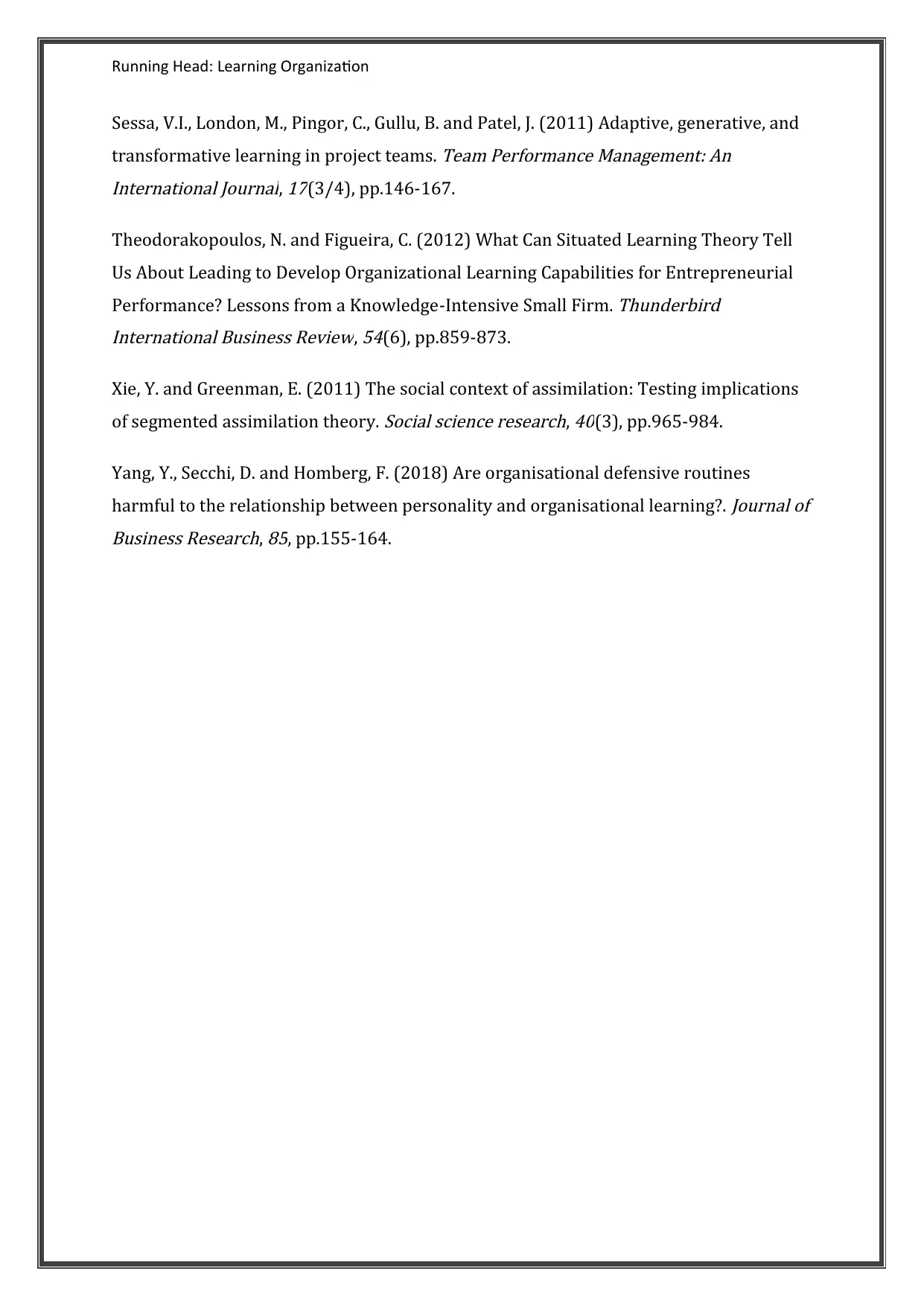
Running Head: Learning Organization
Sessa, V.I., London, M., Pingor, C., Gullu, B. and Patel, J. (2011) Adaptive, generative, and
transformative learning in project teams.
Team Performance Management: An
International Journal,
17(3/4), pp.146-167.
Theodorakopoulos, N. and Figueira, C. (2012) What Can Situated Learning Theory Tell
Us About Leading to Develop Organizational Learning Capabilities for Entrepreneurial
Performance? Lessons from a Knowledge-Intensive Small Firm.
Thunderbird
International Business Review,
54(6), pp.859-873.
Xie, Y. and Greenman, E. (2011) The social context of assimilation: Testing implications
of segmented assimilation theory.
Social science research,
40(3), pp.965-984.
Yang, Y., Secchi, D. and Homberg, F. (2018) Are organisational defensive routines
harmful to the relationship between personality and organisational learning?.
Journal of
Business Research,
85, pp.155-164.
Sessa, V.I., London, M., Pingor, C., Gullu, B. and Patel, J. (2011) Adaptive, generative, and
transformative learning in project teams.
Team Performance Management: An
International Journal,
17(3/4), pp.146-167.
Theodorakopoulos, N. and Figueira, C. (2012) What Can Situated Learning Theory Tell
Us About Leading to Develop Organizational Learning Capabilities for Entrepreneurial
Performance? Lessons from a Knowledge-Intensive Small Firm.
Thunderbird
International Business Review,
54(6), pp.859-873.
Xie, Y. and Greenman, E. (2011) The social context of assimilation: Testing implications
of segmented assimilation theory.
Social science research,
40(3), pp.965-984.
Yang, Y., Secchi, D. and Homberg, F. (2018) Are organisational defensive routines
harmful to the relationship between personality and organisational learning?.
Journal of
Business Research,
85, pp.155-164.
Paraphrase This Document
Need a fresh take? Get an instant paraphrase of this document with our AI Paraphraser
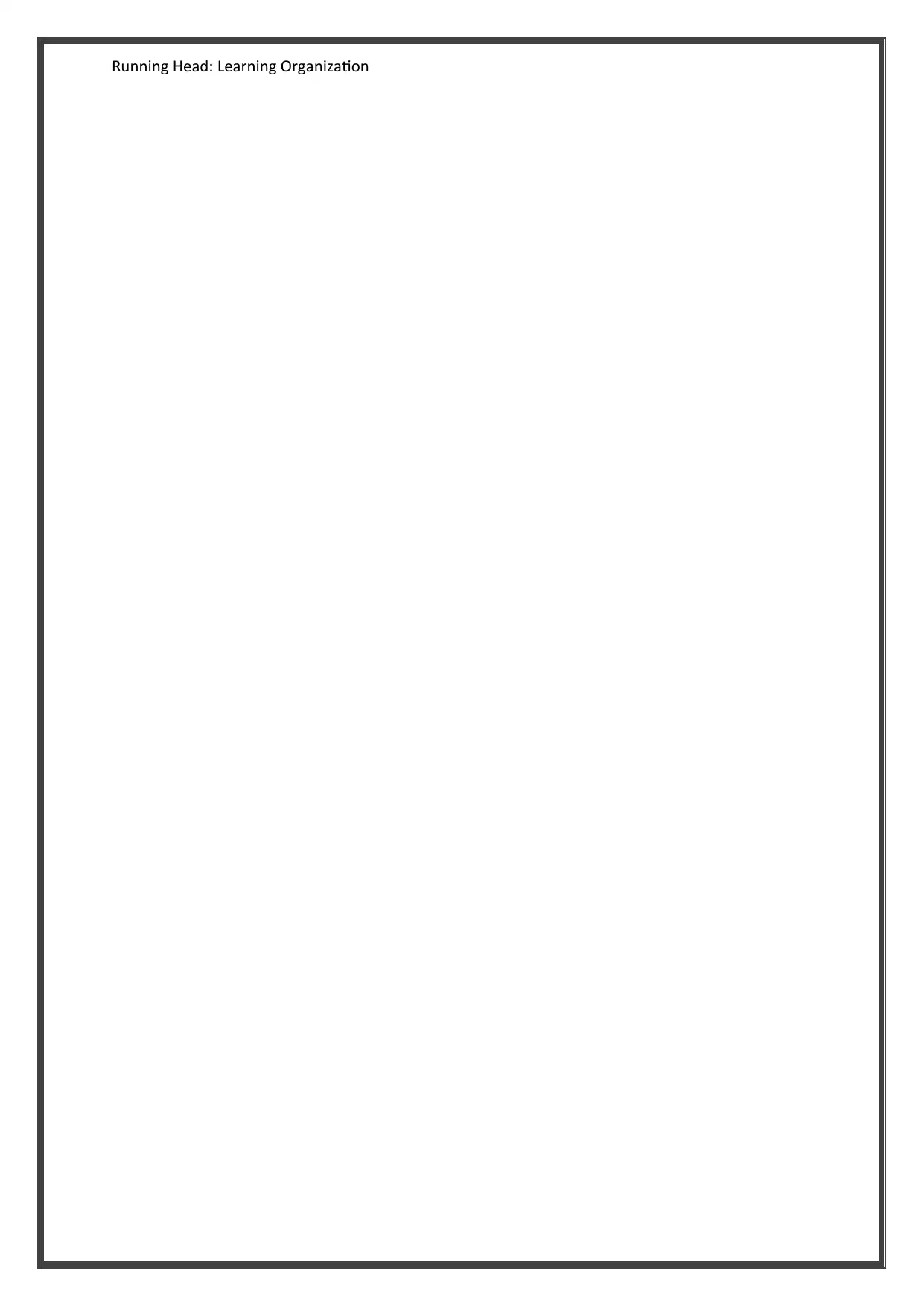
Running Head: Learning Organization
1 out of 8
Related Documents
Your All-in-One AI-Powered Toolkit for Academic Success.
+13062052269
info@desklib.com
Available 24*7 on WhatsApp / Email
![[object Object]](/_next/static/media/star-bottom.7253800d.svg)
Unlock your academic potential
Copyright © 2020–2025 A2Z Services. All Rights Reserved. Developed and managed by ZUCOL.





